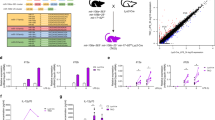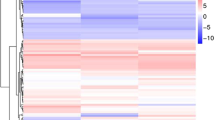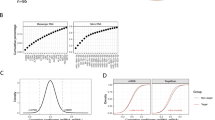Abstract
MicroRNAs (miRNAs) function as important regulators in the immune response and inflammation. Several approaches have been reported to computationally predict miRNAs and their potential targets. However, there are still many miRNA–target interactions that are unpredictable by using the current computational algorithms. We established a miRNA in vivo precipitation method (miRIP) to identify unpredictable miRNAs with definite targets in these cells. Because Stat3 is a well-known transcription factor involved in innate immunity and inflammation, we utilized the miRIP method to identify miRNAs that bind Stat3 mRNA in macrophages. Among the captured miRNAs, miR-151-3p was confirmed to interact with Stat3 mRNA 3′-UTR and downregulate the Stat3 protein levels. LPS stimulation decreased miR-151-3p expression, thereby increasing IL-6 production. Therefore, we found that miR-151-3p inhibited LPS-induced IL-6 production by targeting Stat3. These data further confirmed miRIP as an efficient method to identify unpredictable miRNAs and explore miRNAs-mediated regulation in innate immunity and inflammation.
This is a preview of subscription content, access via your institution
Access options
Subscribe to this journal
Receive 12 digital issues and online access to articles
$119.00 per year
only $9.92 per issue
Buy this article
- Purchase on Springer Link
- Instant access to full article PDF
Prices may be subject to local taxes which are calculated during checkout






Similar content being viewed by others
References
Mehta A, Baltimore D . MicroRNAs as regulatory elements in immune system logic. Nat Rev Immunol 2016; 16: 279–294.
Mendell JT, Olson EN . MicroRNAs in stress signaling and human disease. Cell 2012; 148: 1172–1187.
Wu X, Dai Y, Yang Y, Huang C, Meng X, Wu B et al. Emerging role of microRNAs in regulating macrophage activation and polarization in immune response and inflammation. Immunology 2016; 148: 237–248.
Liu J, Cao X . Cellular and molecular regulation of innate inflammatory responses. Cell Mol Immunol 2016; 13: 711–721.
Liu J, Qian C, Cao X . Post-Translational Modification Control of Innate Immunity. Immunity 2016; 45: 15–30.
Alvarez-Errico D, Vento-Tormo R, Sieweke M, Ballestar E . Epigenetic control of myeloid cell differentiation, identity and function. Nat Rev Immunol 2015; 15: 7–17.
O'Connell RM, Rao DS, Baltimore D . microRNA regulation of inflammatory responses. Annu Rev Immunol 2012; 30: 295–312.
Forster SC, Tate MD, Hertzog PJ . MicroRNA as type I interferon-regulated transcripts and modulators of the innate immune response. Front Immunol 2015; 6: 1–9.
Smyth LA, Boardman DA, Tung SL, Lechler R, Lombardi G . MicroRNAs affect dendritic cell function and phenotype. Immunology 2015; 144: 197–205.
Li Y, Shi X . MicroRNAs in the regulation of TLR and RIG-I pathways. Cell Mol Immunol 2013; 10: 65–71.
Androulidaki A, Iliopoulos D, Arranz A, Doxaki C, Schworer S, Zacharioudaki V et al. The kinase Akt1 controls macrophage response to lipopolysaccharide by regulating MicroRNAs. Immunity 2009; 31: 220–231.
Taganov KD, Boldin MP, Chang K-J, Baltimore D . NF-kappaB-dependent induction of microRNA miR-146, an inhibitor targeted to signaling proteins of innate immune responses. Proc Natl Acad Sci USA 2006; 103: 12481–12486.
Ma F, Xu S, Liu X, Zhang Q, Xu X, Liu M et al. The microRNA miR-29 controls innate and adaptive immune responses to intracellular bacterial infection by targeting interferon-gamma. Nat Immunol 2011; 12: 861–869.
Garbers C, Aparicio-Siegmund S, Rose-John S . The IL-6/gp130/STAT3 signaling axis: recent advances towards specific inhibition. Curr Opin Immunol 2015; 34: 75–82.
Yang J, Liao X, Agarwal MK, Barnes L, Auron PE, Stark GR . Unphosphorylated STAT3 accumulates in response to IL-6 and activates transcription by binding to NF kappa B. Genes Dev 2007; 21: 1396–1408.
Chen Q, Wang H, Liu Y, Song Y, Lai L, Han Q et al. Inducible MicroRNA-223 down-regulation promotes TLR-triggered IL-6 and IL-1 beta production in macrophages by targeting STAT3. PLoS One 2012; 7: e42971.
Ichiba M, Nakajima K, Yamanaka Y, Kiuchi N, Hirano T . Autoregulation of the Stat3 gene through cooperation with a cAMP-responsive element-binding protein. J Biol Chem 1998; 273: 6132–6138.
Carraro G, El-Hashash A, Guidolin D, Tiozzo C, Turcatel G, Young BM et al. miR-17 family of microRNAs controls FGF10-mediated embryonic lung epithelial branching morphogenesis through MAPK14 and STAT3 regulation of E-Cadherin distribution. Dev Biol 2009; 333: 238–250.
Surdziel E, Cabanski M, Dallmann I, Lyszkiewicz M, Krueger A, Ganser A et al. Enforced expression of miR-125b affects myelopoiesis by targeting multiple signaling pathways. Blood 2011; 117: 4338–4348.
Haghikia A, Missol-Kolka E, Tsikas D, Venturini L, Brundiers S, Castoldi M et al. Signal transducer and activator of transcription 3-mediated regulation of miR-199a-5p links cardiomyocyte and endothelial cell function in the heart: a key role for ubiquitin-conjugating enzymes. Eur Heart J 2011; 32: 1287–1297.
Su X, Wang H, Ge W, Yang M, Hou J, Chen T et al. An in vivo method to identify microRNA targets not predicted by computation algorithms: p21 targeting by miR-92a in cancer. Cancer Res 2015; 75: 2875–2885.
Li X, Zhang Q, Ding Y, Liu Y, Zhao D, Zhao K et al. Methyltransferase Dnmt3a upregulates HDAC9 to deacetylate the kinase TBK1 for activation of antiviral innate immunity. Nat Immunol 2016; 17: 806–815.
Bode JG, Ehlting C, Haeussinger D . The macrophage response towards LPS and its control through the p38(MAPK)-STAT3 axis. Cell Signal 2012; 24: 1185–1194.
Witkos TM, Koscianska E, Krzyzosiak WJ . Practical aspects of microRNA target prediction. Curr Mol Med 2011; 11: 93–109.
Easow G, Teleman AA, Cohen SM . Isolation of microRNA targets by miRNP immunopurification. RNA 2007; 13: 1198–1204.
Karginov FV, Conaco C, Xuan Z, Schmidt BH, Parker JS, Mandel G et al. A biochemical approach to identifying microRNA targets. Proc Natl Acad Sci USA 2007; 104: 19291–19296.
Andachi Y . A novel biochemical method to identify target genes of individual microRNAs: identification of a new Caenorhabditis elegans let-7 target. RNA 2008; 14: 2440–2451.
Hsu RJ, Yang HJ, Tsai HJ . Labeled microRNA pull-down assay system: an experimental approach for high-throughput identification of microRNA-target mRNAs. Nucleic Acids Res 2009; 37: e77.
Tan LP, Seinen E, Duns G, de Jong D, Sibon OCM, Poppema S et al. A high throughput experimental approach to identify miRNA targets in human cells. Nucleic Acids Res 2009; 37: e137.
Jaskiewicz L, Bilen B, Hausser J, Zavolan M . Argonaute CLIP—A method to identify in vivo targets of miRINAs. Methods 2012; 58: 106–112.
Vencken S, Hassan T, McElvaney NG, Smith SGJ, Greene CM . miR-CATCH: microRNA capture affinity technology. Methods Mol Biol 2015; 1218: 365–373.
Wei K, Yan F, Xiao H, Yang X, Xie G, Xiao Y et al. Affinity purification of binding miRNAs for messenger RNA fused with a common tag. Int J Mol Sci 2014; 15: 14753–14765.
Ogura H, Murakami M, Okuyama Y, Tsuruoka M, Kitabayashi C, Kanamoto M et al. Interleukin-17 promotes autoimmunity by triggering a positive-feedback loop via interleukin-6 induction. Immunity 2008; 29: 628–636.
Stritesky GL, Muthukrishnan R, Sehra S, Goswami R, Pham D, Travers J et al. The transcription factor STAT3 is required for T helper 2 cell development. Immunity 2011; 34: 39–49.
Laurence A, Amarnath S, Mariotti J, Kim YC, Foley J, Eckhaus M et al. STAT3 transcription factor promotes instability of nTreg cells and limits generation of iTreg cells during acute murine graft-versus-host disease. Immunity 2012; 37: 209–222.
Milner JD, Brenchley JM, Laurence A, Freeman AF, Hill BJ, Elias KM et al. Impaired T(H)17 cell differentiation in subjects with autosomal dominant hyper-IgE syndrome. Nature 2008; 452: 773–776.
Wang P, Xue Y, Han Y, Lin L, Wu C, Xu S et al. The STAT3-binding long noncoding RNA lnc-DC controls human dendritic cell differentiation. Science 2014; 344: 310–313.
Kumar V, Cheng P, Condamine T, Mony S, Languino LR, McCaffrey JC et al. CD45 phosphatase inhibits STAT3 transcription factor activity in myeloid cells and promotes tumor-associated macrophage differentiation. Immunity 2016; 44: 303–315.
Seo YJ, Jeong M, Lee KT, Jang DS, Choi JH . Isocyperol, isolated from the rhizomes of Cyperus rotundus, inhibits LPS-induced inflammatory responses via suppression of the NF-kappa B and STAT3 pathways and ROS stress in LPS-stimulated RAW 264.7 cells. Int Immunopharmacol 2016; 38: 61–69.
Cao X . Self-regulation and cross-regulation of pattern-recognition receptor signalling in health and disease. Nat Rev Immunol 2016; 16: 35–50.
Zhang Y, Cao X . Long noncoding RNAs in innate immunity. Cell Mol Immunol 2016; 13: 138–147.
Shan K, Pang R, Zhao C, Liu X, Gao W, Zhang J et al. IL-17-triggered downregulation of miR-497 results in high HIF-1alpha expression and consequent IL-1beta and IL-6 production by astrocytes in EAE mice. Cell Mol Immunol 2017; 14: 1–15.
Ouimet M, Koster S, Sakowski E, Ramkhelawon B, van Solingen C, Oldebeken S et al. Mycobacterium tuberculosis induces the miR-33 locus to reprogram autophagy and host lipid metabolism. Nat Immunol 2016; 17: 677–686.
Moffett HF, Cartwright ANR, Kim H-J, Godec J, Pyrdol J, Aijo T et al. The microRNA miR-31 inhibits CD8(+) T cell function in chronic viral infection. Nat Immunol 2017; 18: 791–799.
Luedde T . MicroRNA-151 and its hosting gene FAK (focal adhesion kinase) regulate tumor cell migration and spreading of hepatocellular carcinoma. Hepatology 2010; 52: 1164–1166.
Garcia-Lopez J, de Dios Hourcade J, del Mazo J . Reprogramming of microRNAs by adenosine-to-inosine editing and the selective elimination of edited microRNA precursors in mouse oocytes and preimplantation embryos. Nucleic Acids Res 2013; 41: 5483–5493.
Acknowledgements
We thank Dr Taoyong Chen and Dr Mingjin Yang for helpful discussion and Ms Mei Jin for technical assistance. This work was supported by Grants from the National Key Basic Research Program of China (2013CB530502, 2015CB964403) and the National Natural Science Foundation of China (31470849, 31390431 and 81471569), and the Shanghai Committee of Science and Technology (2015QA1404700).
Author information
Authors and Affiliations
Corresponding author
Ethics declarations
Competing interests
There were no financial disclosures from any authors.
Additional information
Supplementary Information for this article can be found on the Cellular & Molecular Immunology website
Supplementary information
Rights and permissions
About this article
Cite this article
Liu, X., Su, X., Xu, S. et al. MicroRNA in vivo precipitation identifies miR-151-3p as a computational unpredictable miRNA to target Stat3 and inhibits innate IL-6 production. Cell Mol Immunol 15, 99–110 (2018). https://doi.org/10.1038/cmi.2017.82
Received:
Revised:
Accepted:
Published:
Issue Date:
DOI: https://doi.org/10.1038/cmi.2017.82
Keywords
This article is cited by
-
4-Octyl itaconate attenuates LPS-induced acute kidney injury by activating Nrf2 and inhibiting STAT3 signaling
Molecular Medicine (2023)
-
Integrated analysis of inflammatory mRNAs, miRNAs, and lncRNAs elucidates the molecular interactome behind bovine mastitis
Scientific Reports (2023)
-
Identification of miRNAs Involved in Intracranial Aneurysm Rupture in Cigarette-Smoking Patients
Neurology and Therapy (2023)
-
MiR-30a-centered molecular crosstalk regulates Th17 differentiation
Cellular & Molecular Immunology (2022)
-
MicroRNA expression profiling of cerebrospinal fluid/serum exosomes in children with human herpesvirus 6-associated encephalitis/encephalopathy by high-throughput sequencing
Journal of NeuroVirology (2022)



